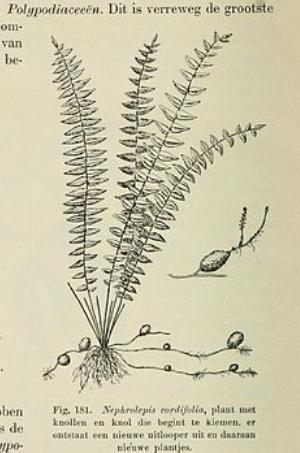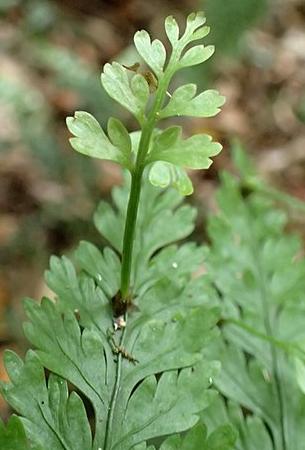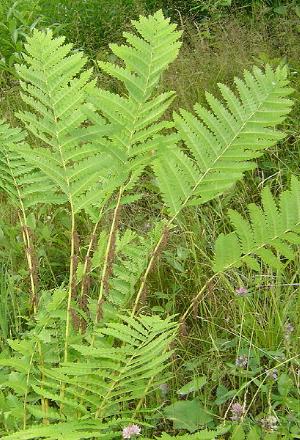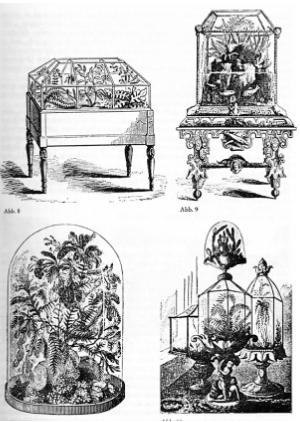|
|
|
|
Spore-Cases |
Foliage from Corkscrew Hill in County Clare on 18 June |
Form near Cadgwith in Kent |
|
Common Name |
Hartstongue from Polypody Family |
||
Botanical Name |
Phyllitis scolopendrium (Syn. Scolopendrium vulgare, Asplenium scolopendrium) |
||
Soil |
Rocky woods and hedgebanks, shady rocks and walls and common in the wetter districts throughout the British Isles. |
||
Sun Aspect |
Part Shade |
||
Soil Moisture |
Dry |
||
Plant Type |
Short rhizome, which is stout, erect and densely clothed with narrow brown scales. |
||
Height x Spread in inches (cms) |
24 x 24 (60 x 60) |
||
Foliage |
Our only true fern with undivided dark green leaves, which are in tufts and pointed strap-shaped, and may be anything from a few inches to 2 feet long, 2 inches across, with rounded base. |
||
Spore Colour in Months(s). |
Spore-cases in diagonal rows on the underside of the leaves. Spores ripen in July-August |
||
Comment |
Native UK fern. See Asplenium scolopendrium in The Fern Gallery. Available from Thimble Farms and KPR |
||
|
|
|
|
Spore-Cases |
Single Leaf from Corkscrew Hill in County Clare on 18 June |
Form near Cadgwith in Kent |
|
|
|
|
|
Spores Case Closed |
Spores Case Open |
Juvenile Spores |
|
|
|||
UKButterflies Larval Foodplants website page lists the larval foodplants used by British butterflies. The name of each foodplant links to a Google search. An indication of whether the foodplant is a primary or secondary food source is also given. Please note that the Butterfly you see for only a short time has grown up on plants as an egg, caterpillar and chrysalis for up to 11 months, before becoming a butterfly. If the plants that they live on during that time are removed, or sprayed with herbicide, then you will not see the butterfly. |
Sewage Pollution in the UK rivers and its surrounding Seas:- This is being ignored by the UK Government, Local UK Government and Commerce, so again they will do nothing about this, and continue to ignore the death of the wildlife, marine life, the dairy, farming and fishing industries, together with the onland and ocean producers of oxygen during 2024. Why not visit the UK and add your excrement to the increase of 102% of raw sewage spills into rivers and the seas in 2023 from 2022, while 240,000 new homes will be built each year without the future Labour or Conservative government stopping their excrement being offloaded into the sea to affect all the other countries surrounding us. If 92% of the seagrass has been smothered that means nowhere round the UK is either safe to swim in or for its fish and other marine life. The same could be said about the farmed salmon in the seas round Scotland and any fish caught in the rivers of the UK. Ocean Pollution as reported by the Marine Conservation Society Marine pollution is diverse, from tiny fibres which shed from clothes, to chemicals washed down the sink. Pollutants, including plastic, chemicals and bacteria travel from our towns and cities to our seas, as well as from activities directly in our ocean. If we don’t tackle pollution at source, these highly persistent chemicals and plastics will continue to increase in our ocean causing untold damage. That's where we come in.
------
Marine Conservation Society - Seagrass: The ocean superhero at risk from sewage:-Seagrass meadows are a key player in helping to combat climate change – but untreated sewage pollution in our seas is threatening their future. Seagrass meadows are the Swiss army knife of marine habitats. They create hotspots for biodiversity and provide vital nursery habitats for various fish species. Long seagrass blades buffer wave energy, protecting our shores against coastal erosion and storms. Their canopies slow the flow of water, drawing down suspended matter like pollutants and excess nutrients from the water column and burying it in the sediment below. This also makes them one of the oldest and most effective carbon storage technologies, accounting for an estimated 10-18% of ocean carbon storage while occupying only 0.1% of the seafloor. Unlike terrestrial habitats like forests, seagrass doesn't release the carbon it has captured back into the atmosphere when it decomposes. If undisturbed, seagrass can store carbon for thousands of years. Seagrasses do a lot of heavy lifting in mitigating the stress that we inflict on the ocean. As ecosystem engineers, they’re skilled at adapting their environment to suit their needs. However, the flow of untreated sewage discharges into UK seas is posing a problem for seagrass. Untreated sewage discharges contain excess nutrients and pathogens, which encourage faster-growing macroalgae which reduce light availability and epiphytic algae which smother the seagrass leaves. Research by Cardiff University and Swansea University indicates that insufficient monitoring and management of sewage and wastewater treatment threatens seagrass meadows around the UK. Each of the 11 sites sampled in the study, ten of which were within marine protected areas, contained seagrass that was contaminated by nutrients “of a human and livestock waste origin”. The findings show that sewage pollution is a stressor to seagrass – one whose effects are far-reaching and continues to have an impact far from its source. The only effective way to protect seagrass and the whole marine environment from this stress is to tackle the issue at source. We have already lost 92% of seagrass meadows in the UK, and their survival and recovery is further undermined by poor water quality. However, we can reverse this trend. Removing stressors, such as untreated sewage pollution, is the most important factor in allowing seagrass to recover and we have seen seagrass successfully recolonise areas which were previously wiped out by sewage outfall. Our seagrass meadows are an essential ally against global warming, a biodiversity crisis, and pervasive pollution. These superhero habitats need our help and a first major step towards this is to stop releasing untreated sewage into our seas.
|
|||||||
Plants used by the Butterflies follow the Plants used by the Egg, Caterpillar and Chrysalis as stated in |
||||||||
Plant Name |
Butterfly Name |
Egg/ Caterpillar/ Chrysalis/ Butterfly |
Plant Usage |
Plant Usage Months |
||||
Egg, |
1 egg under leaf. |
10 days in May-June |
||||||
Egg, |
Eggs laid in batches encircling the branch of the food plant. |
Hatches after 18-22 days in April. |
||||||
Egg, |
Groups of eggs on upper side of leaf. |
- |
||||||
Egg, |
1 egg at base of plant. |
Late August-April |
||||||
Egg, |
Groups of eggs on upper side of leaf. |
- |
||||||
Egg, |
1 egg laid on underside of leaflets or bracts. |
7 days in June. |
||||||
Egg, |
1 egg laid on underside of leaflets or bracts. |
7 days in June. |
||||||
Egg, |
1 egg laid under the leaf or on top of the flower. |
7 days in August. |
||||||
Egg, |
1 egg on underside of a flower bud on its stalk. |
7 days. |
||||||
Egg, |
1 egg on underside of a flower bud on its stalk. |
7 days. |
||||||
Egg, |
1 egg under leaf. |
10 days in May-June. |
||||||
Egg, |
1 egg on leaf. |
2 weeks |
||||||
Cabbages - Large White eats all cruciferous plants, such as cabbages, mustard, turnips, radishes, cresses, nasturtiums, wild mignonette and dyer's weed |
Egg,
|
40-100 eggs on both surfaces of leaf. |
May-June and August-Early September. 4.5-17 days. |
|||||
Egg, |
1 egg on underside of leaf. |
May-June and August. 7 days. |
||||||
Cabbages:- |
Egg, |
1 egg on underside of leaf. |
July or August; hatches in 3 days. |
|||||
Cabbages:- |
Egg, |
1 egg laid in the tight buds and flowers. |
May-June 7 days. |
|||||
Cherry with |
Egg, |
Eggs laid in batches encircling the branch of the food plant. |
Hatches after 18-22 days in April. |
|||||
Egg, |
Groups of eggs on upper side of leaf. |
- |
||||||
Egg, |
1 egg on leaf. |
10 days in May-June. |
||||||
Egg, |
1 egg on leaf. |
6 days in May-June. |
||||||
Egg, |
1 egg under leaf. |
|
||||||
|
(Common CowWheat, Field CowWheat) |
Egg, |
Eggs laid in batches on the under side of the leaves. |
Hatches after 16 days in June. |
|||||
Currants |
Egg, |
Groups of eggs on upper side of leaf. |
|
|||||
Egg, |
Eggs laid in batches on the under side of the leaves. |
Hatches after 20 days in July. |
||||||
Dog Violet with |
Egg, |
1 egg on oak or pine tree trunk |
15 days in July. |
|||||
Dog Violet with |
Egg, |
1 egg on leaf or stem. |
Hatches after 15 days in May-June. |
|||||
Dog Violet with |
Egg, |
1 egg on leaf or stem. |
Hatches after 10 days in May-June. |
|||||
Egg, |
1 egg on underside of a flower bud on its stalk. |
7 days. |
||||||
Egg, |
Eggs laid in batches encircling the branch of the food plant. |
Hatches after 18-22 days in April. |
||||||
False Brome is a grass (Wood Brome, Wood False-brome and Slender False-brome) |
Egg, |
1 egg under leaf. |
... |
|||||
Egg, |
Eggs laid in batches on the under side of the leaves. |
Hatches after 20 days in July. |
||||||
Egg, |
1 egg laid on underside of leaflets or bracts. |
7 days in June. |
||||||
Egg, |
1 egg on leaf or stem. |
Hatches after 10 days in May-June. |
||||||
Egg, |
1 egg on underside of a flower bud on its stalk. |
7 days. |
||||||
Egg, |
1 egg laid under the leaf or on top of the flower. |
7 days in August. |
||||||
Egg, |
1 egg on leaf. 5 or 6 eggs may be deposited by separate females on one leaf. |
14 days in July-August. |
||||||
Egg, |
1 egg on underside of a flower bud on its stalk. |
7 days. |
||||||
Egg, |
1 egg laid in the tight buds and flowers. |
May-June 7 days. |
||||||
Egg, |
Eggs laid in batches on the under side of the leaves. |
Hatches after 20 days in July. |
||||||
Egg, |
Groups of eggs on upper side of leaf. |
|
||||||
Egg, |
1 egg under leaf. |
1 then |
||||||
Egg, |
1 egg on underside of a flower bud on its stalk. |
7 days. |
||||||
Egg, |
1 egg at base of plant. |
Late August-April. |
||||||
Egg, |
1 egg on leaf. |
10 days in May-June. |
||||||
Egg, |
1 egg on leaf. |
2 weeks |
||||||
Egg, |
1 egg on leaf. |
6 days in May-June. |
||||||
Egg, |
1 egg on underside of leaf. |
May-June and August. 7 days. |
||||||
Egg, |
1 egg on leaf. 5 or 6 eggs may be deposited by separate females on one leaf. |
14 days in July-August. |
||||||
Narrow-leaved Plantain (Ribwort Plantain) |
Egg, |
Eggs laid in batches on the under side of the leaves. |
Hatches after 16 days in June. |
|||||
Narrow-leaved Plantain (Ribwort Plantain) |
Egg, |
Eggs laid in batches on the under side of the leaves. |
Hatches after 16 days in June. |
|||||
Nasturtium from Gardens |
Egg, |
1 egg on underside of leaf. |
May-June and August. 7 days. |
|||||
Egg, |
1 egg on tree trunk |
15 days in July. |
||||||
Mountain pansy, |
Egg, Chrysalis |
1 egg laid under the leaf or on top of the flower. |
7 days in August. 3 weeks in September |
|||||
Egg, |
1 egg on tree trunk. |
15 days in July. |
||||||
Egg, |
Eggs laid in batches on the under side of the leaves. |
Hatches after 20 days in July. |
||||||
Egg, |
Eggs laid in batches encircling the branch of the food plant. |
Hatches after 18-22 days in April. |
||||||
Egg, |
Groups of eggs on upper side of leaf. |
- |
||||||
Egg, |
1 egg under leaf. |
|
||||||
Egg, |
1 egg laid under the leaf or on top of the flower. |
7 days in August. |
||||||
Egg, |
Eggs laid in batches encircling the branch of the food plant. |
Hatches after 18-22 days in April. |
||||||
Egg, |
Eggs laid in batches on the under side of the leaves. |
Hatches after 16 days in June. |
||||||
Egg, |
1 egg on underside of a flower bud on its stalk. |
7 days. |
||||||
Egg, |
1 egg on underside of a flower bud on its stalk. |
7 days. |
||||||
Egg, |
Groups of eggs on upper side of leaf. |
|
||||||
Egg, |
1 egg under leaf. |
|
||||||
Egg, |
1 egg on leaf. |
2 weeks |
||||||
Trefoils 1, 2, 3 |
Egg, |
1 egg on leaf. |
6 days in May-June. |
|||||
Egg, |
Groups of eggs on upper side of leaf. |
- |
||||||
Egg, |
1 egg laid on underside of leaflets or bracts. |
7 days in June. |
||||||
Violets:- |
Egg, |
1 egg on underside of leaf or on stalk. |
July-August for 17 days. |
|||||
Violets:- |
Egg, |
1 egg on stem or stalk near plant base. |
July to hatch in 8 months in March. |
|||||
Egg, |
1 egg on leaf. |
2 weeks. |
||||||
Egg, |
Eggs laid in batches encircling the branch of the food plant. |
Hatches after 18-22 days in April. |
||||||
Egg, |
1 egg on leaf. 5 or 6 eggs may be deposited by separate females on one leaf. |
14 days in July-August. |
||||||
Willow |
Egg, |
Eggs laid in batches encircling the branch of the food plant. |
Hatches after 18-22 days in April. |
|||||
Egg, |
Eggs laid in batches on the under side of the leaves. |
Hatches after 20 days in July. |
||||||
Plants used by the Butterflies |
||||||||
Plant Name |
Butterfly Name |
Egg/ Caterpillar/ Chrysalis/ Butterfly |
Plant Usage |
Plant Usage Months |
||||
Asters |
Butterfly |
Eats nectar. |
|
|||||
Runner and Broad Beans in fields and gardens |
Butterfly |
Eats nectar |
April-June or July-September. |
|||||
Aubretia in gardens |
Butterfly |
Eats nectar |
May-June or August till killed by frost and damp in September-November |
|||||
Butterfly |
Eats sap exuding from trunk. |
April-Mid June and Mid July-Early September for second generation. |
||||||
Butterfly |
Eats nectar. |
20 days. |
||||||
Butterfly |
Eats nectar |
May-June |
||||||
Holly Blue |
Butterfly |
Eats nectar |
April-Mid June and Mid July-Early September for second generation. |
|||||
Butterfly |
Eats nectar. |
July-October. |
||||||
Buddleias |
Butterfly |
Eats nectar. |
July-October. |
|||||
Wood White |
Butterfly |
Eats nectar |
May-June. |
|||||
Cabbage and cabbages in fields |
Butterfly |
Eats nectar |
April-June or July-September. |
|||||
Butterfly |
Eats nectar |
July-October |
||||||
Adonis Blue |
Butterfly |
Eats nectar. |
1 Month during Mid-May to Mid-June or during August-September |
|||||
Pale Clouded Yellow |
Butterfly |
Eats nectar |
May-June or August till killed by frost and damp in September-November |
|||||
Cow-wheat |
Butterfly |
Eats nectar |
June-July |
|||||
Butterfly |
Eats nectar |
May-June |
||||||
Butterfly |
Eats nectar |
April-Mid June and Mid July-Early September for second generation. |
||||||
Butterfly |
Eats nectar. |
3 weeks between May and September |
||||||
Germander Speedwell (Veronica chamaedrys - Birdseye Speedwell) |
Butterfly |
Eats nectar |
June-July |
|||||
Butterfly |
Eats nectar. |
July-October. |
||||||
Butterfly |
Eats nectar |
30 days in May-June. |
||||||
Butterfly |
Eats nectar |
May-September |
||||||
Butterfly |
Eats nectar. |
May-June for 18 days. |
||||||
Butterfly |
Eats nectar. |
July-October |
||||||
Butterfly |
Eats nectar. |
1 Month. |
||||||
Butterfly |
Eats nectar. |
July-October. |
||||||
Painted Lady |
Butterfly |
Eats nectar |
July-October. |
|||||
Marigolds in gardens |
Butterfly |
Eats nectar |
May-June or August till killed by frost and damp in September-November |
|||||
Butterfly |
Eats nectar. |
1 Month during Mid-May to Mid-June or during August-September. |
||||||
Michaelmas Daisies |
Butterfly |
Eats nectar. |
July-October |
|||||
Butterfly |
Eats nectar |
April-June or July-September. |
||||||
Narrow-leaved Plantain (Ribwort Plantain) |
Butterfly |
Eats nectar |
June-July |
|||||
Nasturtiums in gardens |
Butterfly |
Eats nectar |
April-June or July-September |
|||||
Butterfly |
Eats sap exuding from trunk. |
April-Mid June and Mid July-Early September for second generation. |
||||||
Butterfly |
Eats nectar |
June. |
||||||
Butterfly |
Eats nectar |
May-June. |
||||||
Butterfly |
Eats nectar |
July-October. |
||||||
Butterfly |
Eats nectar |
July-May |
||||||
Butterfly |
Eats nectar |
7 weeks in July-August. |
||||||
Comma |
Butterfly |
Eats nectar. |
July-October. |
|||||
Butterfly |
Eats nectar. |
3 weeks between May and September |
||||||
Trefoils 1, 2, 3 |
Butterfly |
Eats nectar. |
1 Month during Mid-May to Mid-June or during August-September |
|||||
Butterfly |
Eats nectar. |
20 days in August. |
||||||
Butterfly |
Eats nectar |
June.
|
||||||
Butterfly |
Eats nectar |
June-July |
||||||
Apple/Pear/Cherry/Plum Fruit Tree Blossom in Spring |
Butterfly |
Eats Nectar |
April-May |
|||||
Rotten Fruit |
Butterfly |
Drinks juice |
July-September |
|||||
Tree sap and damaged ripe fruit, which are high in sugar |
Butterfly |
Hibernates inside hollow trees or outhouses until March. Eats sap or fruit juice until April. |
10 months in June-April |
|||||
Wild Flowers |
Large Skipper |
Butterfly |
Eats Nectar |
June-August |
||||
Links to the other Butterflies:- Black Hairstreak |
||||||||
THE LIFE AND DEATH OF A FLAILED CORNISH HEDGE
September 21st. Most of the survey mile closely flailed today along both sides of the road. End note, June 2008. I hear spring vetch has been officially recorded somewhere in West Cornwall and confirmed as a presence in the county, so perhaps I can be permitted to have seen it pre-1972 in the survey mile. I wonder where they found it? It's gone from hedges where it used to be, along with other scarcities and so-called scarcities that used to flourish in so many hedges unrecorded, before the flail arrived. I have given careful thought to including mention of some of the plants and butterflies. So little seems to be known of the species resident in Cornish hedges pre-flail that I realise some references may invite scepticism. I am a sceptic myself, so sympathise with the reaction; but I have concluded that, with a view to re-establishing vulnerable species, it needs to be known that they can with the right management safely and perpetually thrive in ordinary Cornish hedges. In future this knowledge could solve the increasingly difficult question of sufficient and suitable sites for sustainable wild flower and butterfly conservation - as long as it is a future in which the hedge-flail does not figure.
CHECK-LIST OF TYPES OF CORNISH HEDGE FLORA by Sarah Carter of Cornish Hedges Library:-
Titles of papers available on www.cornishhedges.co.uk:-
THE GUILD OF CORNISH HEDGERS is the non-profit-making organisation founded in 2002 to support the concern among traditional hedgers about poor standards of workmanship in Cornish hedging today. The Guild has raised public awareness of Cornwall's unique heritage of hedges and promoted free access to the Cornish Hedges Library, the only existing source of full and reliable written knowledge on Cornish hedges." |
||||||||
|
|||||||||||||||||||||||||||||||||||||||||||||||||||||||||||||||||||||||||||||
DUCKWEED TO FERN WILD FLOWER GALLERY
SEED COLOUR |
GBIF makes available data that are shared by hundreds of data publishers from around the world. These data are shared according to the GBIF Data Use Agreement, which includes the provision that users of any data accessed through or retrieved via the GBIF Portal will always give credit to the original data publishers. What is the Global Biodiversity Information Facility? GBIF enables free and open access to biodiversity data online. We’re an international government-initiated and funded initiative focused on making biodiversity data available to all and anyone, for scientific research, conservation and sustainable development. GBIF provides three core services and products:
|
||||||||||||||||||||||||||||||||||||||||||||||||||||||||||||||||||||||||||||
WILD FLOWER GALLERY INDEX LINK TO WILDFLOWER PLANT DESCRIPTION PAGE Wildflower Garden Use page from Evergreen Perrennial Shape Gallery. FLOWER COLOUR SEED COLOUR BED PICTURES HABITAT TABLES See Explanation of Structure of this Website with User Guidelines to aid your use of this website. |
WILD FLOWER FAMILY
|
WILD FLOWER FAMILY
|
WILD FLOWER FAMILY
|
WILD FLOWER FAMILY
|
Wild About Britain is home to hundreds of thousands of pages about British wildlife, the Environment and the Great Outdoors; from birds, butterflies, fungi and trees to climate change, marine life, astronomy and the weather. We're also a huge online community with 35,000 members and more than 3 million unique visitors a year. World Atlas of Seagrasses by Edmund P. Green and Frederick T. Short - "a group of about sixty species of underwater marine flowering plants, grow in the shallow marine and estuary environments of all the world's continents except Antarctica. The primary food of animals such as manatees, dugongs, and green sea turtles, and critical habitat for thousands of other animal and plant species, seagrasses are also considered one of the most important shallow-marine ecosystems for humans, since they play an important role in fishery production. Though they are highly valuable ecologically and economically, many seagrass habitats around the world have been completely destroyed or are now in rapid decline. The World Atlas of Seagrasses is the first authoritative and comprehensive global synthesis of the distribution and status of this critical marine habitat. " Over 300 accounts of the Flora of the British Isles have been published in |
||||||||||||||||||||||||||||||||||||||||||||||||||||||||||||||||||||||||
Superceeded Wildflower Indices After clicking on the WILD FLOWER Common Name INDEX link to Wildflower Family Page; |
The process below provides a uniform method for
The following Extra Index of Wildflowers is created in the Borage Wildflower Gallery, to which the Wildflowers found in the above list will have that row entry copied to.
Having transferred the Extra Index row entry to the relevant Extra Index row for the same type of plant in a gallery below; then
|
||||||||||||||||||||||||||||||||||||||||||||||||||||||||||||||||||||||||||||
The English Flower Garden Design, Arrangement, and Plans |
|||||||||||||||||||||||||||||||||||||||||||||||||||||||||||||||||||||||||||||
KPR - Gardeners Club Slovakia:- "KPR was officially established in 2000 in Slovakia in Europe; however, we supply seeds and plants from all over the world since 1998. Our main object is focused on joining gardeners around the world from all fields of interests to create a big database of seeds and plants (Seeds and Plants Bank of KPR) from around the world. At present, we have 6 main branches (Slovakia, Czechia, Australia, India, Thailand, South Africa and Tanzania) and over 200 co-operators and seeds collectors all over the world. Nowadays we are able to collect and supply over 10 000 species of plants from all over the world. If you are looking for anything, you are at the right place! Although we do not have every plant in our collection yet, but we are expanding daily, step-by-step, seed-by-seed, plant by plant. We believe that soon we will be able to supply (almost) anything! For sale over 10 000 seeds and plants from all over the world - palms, cycads, exotic and frost tolerant shrubs and trees, succulents, carnivorous, annuals, perennials, ornamental grasses, vegetable, etc." "At present, we can collect seeds and plants on request (as well as parts of plants - for example bulbs, cuttings, meristematic tissues, pollen, etc.) from more than 4000 species of plants from 19 European countries. Now we collect in the following countries: Austria, Bulgaria, Czechia, Germany, Spain, Finland, Great Britain, Croatia, Hungary, Lithuania, Latvia, Montenegro, Macedonia, Poland, Portugal, Serbia, Russia, Slovenia, Slovakia. We prepare to collect in the following countries: Albania, Bosnia and Herzegovina, Belarus, Estonia, France, Switzerland, Italy, Kosovo, Norway, Sweden, Ukraine. We are able to collect all species in this area on your request. However, we do not collect protected species and species from the orchids (Orchidaceae). Since 2002, we supply a wide range of European plants annually to both domestic and foreign small gardeners as well as big gardeners' societies, pharmaceutical companies and for scientific research. The Vegetation season in Europe is from March to October. Seeds are usually harvested from August to September, and some species earlier. We provide a guarantee of 2 years for germination seeds. Seeds of some species are available throughout the year, but most of the species are collected on request. If you are searching for anything from Europe, you are at the right place! Contact us and inform yourself about stock availability, prices and terms of supplying. We are able to supply all plant parts as well - seeds, bulbs, cuttings, meristematic issues, pollen etc. We also grow many species in cultivation and supply these as seedlings or young plants for wholesale. If you require seedlings, your order should be placed before April, seeing that the seeds are sown in April."
Colin's virtual Herbarium - "I am Colin Ladyka, and I live in Regina, Saskatchewan, Canada. Native plants are my hobby.
Toxicity of Common Comfrey :-
The Botanical Society of Britain and Ireland – Founded in 1836 as the Botanical Society of London and welcomes both professional and amateur botanists. The society focuses on the study of botany in the British Isles. The British Bryological Society – For the study and conservation of mosses and liverworts worldwide. The British Lichen Society – The first society in the world entirely devoted to the study of lichens. The Natural History Society of Northumbria – Everything you might want to know about NHSN including details of their field meetings, lectures, and nature reserve. Common by Nature – James Common regularly writes about his botanical finds across Newcastle and Northumberland on his personal blog. Help Identifying Plants Online BSBI Plant Crib – Sections from BSBI’s ground-breaking publication make the identification of complex plant families much easier. NatureSpot – Perfect for beginners, this online resource hosts species accounts for many plants also found in the North East. Arable Plant Crib – A series of helpful crib sheets for the UK’s arable plants from the Colour in the Margins project (now ceased). Common’s Cribs – A new series of beginner-friendly crib sheets exploring the identification of various plant families and group.
Biopix is a collection of biological photos, primarily from Scandinavia. Biopix is used online by a wide range of students, teachers, researchers, photographers etc. The photos are used professionally in a large range of publications; the sale helps to cover the expenses.
|
|
Handbook of alien species in Europe
Herbaria@home, a ground-breaking new approach to digitising and documenting the archives of the UK's herbaria. This site provides a web-based method for documenting herbarium sheets. We welcome participation in the project, so please read more about the project and if you would like to help then get involved!
Ukwildflowers has lists of English Common Names with their Latin botanical name.
APHOTOFLORA
Since 1972 I (Leif Stridvall) have almost exclusively been working with Nikon 35 mm system cameras as photographic equipment. They have proved to be very reliable and have never let me down. I started with Nikkormat, later exchanging it for Nikon FA (had matrix metering) and ended up with Nikon 801 (had autofocus) adding Nikon F70 as a reserve camera. In 2001 I began shooting digitally, first with Nikon Coolpix 990 and a couple of years later Minolta Dimage 7Hi, both excellent cameras for close-up photography. However when Nikon last year released its digital system camera D70 at a very affordable price, giving me opportunity to use all my old lenses with their new camera model, I gave up 35 mm photography for good. Since many years I use as macro lens the very sharp Nikon 60/2,8 AF (many old photos are taken with Mikro-Nikkor 3,5/55, also an excellent lens for macro work but only with manual focusing). All my 35 mm photos are taken with slide film, before 1972 Agfacolor, from 1972 till 1991 Kodachrome 25 (very few with Kodachrome 64) and from 1992 onwards with my favourite film, Fuji Velvia, very sharp and contrasty. Slides have been scanned by a HP PhotoSmart S20 Photo Scanner at a fairly moderate resolution of 1200 dpi. Most photos have been slightly edited either in Ulead PhotoImpact or in Adobe Photoshop. Photos with filenames starting with 4 letters are shot with a digital camera (AAAAxxxx or BBBBxxxx indicate Nikon CoolPix 990, MINAxxx Minolta Dimage 7Hi and NIKAxxxx Nikon D70).
The Global Strategy for Plant Conservation grew out of the Convention on Biological Diversity and is being fed into government policy around the world. |
Bookreview of A.R. Clapham, T.G. Tutin et E.F. Warburg Flora of the British Isles. Second Edition. Cambridge University Press.
Ferns in Britain and Ireland - A guide to ferns, horsetails, clubmosses
Selected References from KingdomPlantae.net National Audubon Society Field Guide to North American Wildflowers, Niering and Olmstead Peterson Field Guides Eastern/Central Medicinal Plants, Steven Foster and James A. Duke Peterson Field Guides Edible Wild Plants, Lee Allen Peterson Stalking the Healthful Herbs, Euell Gibbons Identifying and Harvesting Edible and Medicinal Plants, Steve Brill The Encyclopedia of Edible Plants of North America, Francois Couplan, Ph.D. Tom Brown's Guide to Wild Edible and Medicinal Plants, Tom Brown, Jr. A Modern Herbal, Volume II, Mrs. M. Grieve Weeds, Alexander C Martin
---------
Database of Insects and their Food Plants from the Biological Records Centre:- This database is primarily a collation of published interactions between Great Britain 's invertebrate herbivores (insects and mites) and their host plants. There are also some interactions for the invertebrates closely associated with herbivores, such as predators, parasitoids, cleptoparasites and mutualists. DBIF contains about 47,000 interactions for roughly 9,300 invertebrate taxa (species, sub-species and forms) and 5,700 plant taxa (species, genera and broader groupings).
---------
Helping Earth's Sustainable Management with a Plant IT'S SO PRODUCTIVE! 1 acre of hemp = 1,000 gallons of methanol. In fact, Henry Ford's first car ran on hemp-methanol! - and at just a fraction of the cost of petroleum alternatives. Alternatives to coal, fuel oil, acetone, ethyl, tar pitch and creosote can be derived - from this one single plant! |
||||||||||||||||||||||||||||||||||||||||||||||||||||||||||||||||||||||||||
|
|
|
|
|
|
||||||||||||||||||||||||||||||||||||||||||||||||||||||||||||||||||||||||
The New Zealand Electronic Text Centre has under the Creative Commons Attribution-Share Alike 3.0 New Zealand Licence produced the following information from Chapter IX - Ferns for the Open Garden from The Cultivation of New Zealand Plants by L.Cockayne published by Whitcombe and Tombs Limited, 1923, Auckland:- Class 1.—Ferns requiring no shade in dry districts. Class 2.—Ferns requiring only the minimum amount of shade. Class 3.—Ferns requiring a moderate amount of shade. Class 4.—Ferns requiring a considerable amount of shade.
GrassBase - The Online World Grass Flora:- What is GrassBase?
A Vegetative Key to Grasses by Ellen McDouall from the Bristol Regional Environmental Records Centre. |
|
How www.discoverlife.org Works About Everyone can benefit in some way from a partnership with Discover Life. With our powerful integrated web tools, you can:
We are dedicated to improving education about the natural world, and therefore make our tools available for everyone, for free. You keep copyrights of your photographs and other information, you control how much or how little information you provide. We work constantly to improve our technology to make it easier to use."
What is The Threatened Plants Database
BackyardGardener.com:- This is no superficial overview. We have everything you need to learn, explore, and improve your gardening. We also provide every product imaginable to assist you in creating your beautiful home garden surroundings. Backyard Gardener has provided gardening information since 1996. We are a one stop informational site to help people understand their gardening needs. Backyard Gardener provides gardening plans and plant lists to enhance your gardening knowledge. We assist in providing the best gardening reference sites on the web with our own 'hands on' gardening information." |
|||||||||||||||||||||||||||||||||||||||||||||||||||||||||||||||||||||||||||
|
|||||||||||||||||||||||||||||||||||||||||||||||||||||||||||||||||||||||||||||
|
|||||||||||||||||||||||||||||||||||||||||||||||||||||||||||||||||||||||||||||
Monty Don. The Observer, Sunday 22 April 2001 "Weeds are the unwanted visitors which spoil our garden parties. But before you chuck them out, they can teach us a thing or two. There are other ways to deal with weeds:-
My weeds: Monty's list of garden horrors, most of which are detailed in this website - look by common name or botanical in the Cream and Brown Wild Flower Gallery Page menus above:-
|
|||||||||||||||||||||||||||||||||||||||||||||||||||||||||||||||||||||||||||||
|
Site design and content copyright ©May 2008. DISCLAIMER: Links to external sites are provided as a courtesy to visitors. Ivydene Horticultural Services are not responsible for the content and/or quality of external web sites linked from this site. |
|
|||||||||||||||||||||||||||||||||||||||||||||||||||||||||||||||||||||||||||
It is coming from the people of Ecuador, led by their President Rafael Correa, and it would begin to deal with 2 converging crises. In the 4 billion years since life on earth began, there have been 5 times when there was a sudden mass extinction of life-forms. The last time was 65 million years ago, when the dinosaurs were killed, probably by a meteor. But now the world's scientists agree that the 6th mass extinction is at hand. Humans have accelerated the rate of species extinction by a factor of at least 100 and the Harvard biologist EO Wilson warns it could reach a factor of 10,000 within the next 20 years.. We are doing this largely by stripping species of their habitat. At the same time, we are dramatically warming the atmosphere. The joint-hottest year ever recorded was 2010, according to Nasa. The best scientific prediction is that we are now on course for a 3 feet rise in global sea levels this century. Goodbye London, Cairo, Bangkok, Venice and Shanghai. So where does Ecuador come in? At the tip of this South American country, there lies 4,000 square miles of rainforest where the Amazon basin, the Andes mountains and the equator come together. It is the most diverse place on earth. When scientists studied a single hectare of it, they found it had more different species of trees that the whole of North America put together. It holds the world records for different species of amphibeans, reptiles and bats. And - more importantly - this rainforest is a crucial part of the planets lungs, inhaling huge amounts of heat-trapping gases and keeping them out of the atmosphere. Yet almost all the pressure from the outside world today is to cut it down. Why? Because underneath that rainforest, there is almost a billion barrels of untapped oil, containing 400 million tons of planet-cooking gases. The oil beneath the rainforest is worth about 7 billion dollars. Ecuador's democratic government says that, if the rest of the world offers just half of what the oil is worth - 3.5 billion dollars - they will keep the rainforest standing and alive and working for us all. In a country where 38% live in poverty and 13% are on the brink of starvation, it's an incredibly generous offer and one that is popular in the rainforest itself. No country with oil has ever done anything like this before. Not a single one has ever considered leaving it in the ground because the consequences of digging it up are too disastrous. They first made this offer in 2006. Chile has offered $100,000. Spain has offered $1.4million. Germany initially offered $50million, then pulled out. Now Mr Carrea is warning they can't wait forever in a country where 13% are close to starving. If they do not have $100million in the pot by the end of this year, he says, they will have no choice but to pursue Plan B - the digging and destruction of the rainforest." What the idiots in power in the world do not realise is that a 25 feet by 25 feet grass lawn will provide enough oxygen for a person per year. A car travelling 60 miles consumes the same volume of oxygen as a mature beech tree produces in a year. Every person in the UK travels by car, bus or public transport and they therefore consume more oxygen per year than the property they own or the country they live in can create. We get our oxygen from outside the United Kingdom. We owe over 900 billion pounds and now we are lending more than 3.5 billion dollars to Greece, Ireland and Portugal. We are spending £800,000 on dropping 1 missile on Libya and last month we were involved in 3 wars costing more that £3.5 billion a year. UNFORTUNATELY THE GOVERNMENT IS NOT INTERESTED IN THE FACT THAT WE WILL NOT BE ABLE TO BREATHE FAIRLY SOON. Since no government will do it, perhaps you as the individual reading this could send £1 a month by standing order to the Ecuador Embassy in your country, so that President Carrea can carry out Plan A rather than Plan B. |
|||||||||||||||||||||||||||||||||||||||||||||||||||||||||||||||||||||||||||||
From Sarah Ravens Kitchen & Garden:- Wildflowers - Chalk and sand, freely-drained soil mix A wonderfully varied self-sowing wild flower mix for thin, poor, chalky or sandy soils to give your garden or field flowers right through the year and food for the birds and bees. To cover an area of 3m2
|
From Sarah Ravens Kitchen & Garden:- Wildflowers - Clay and rich loam soil mix There are two main things I want from my wildflower meadow –
That’s what you’ll get with this beautiful selection of my favourite easy and reliable perennial wild flowers. To cover an area of 3m2
Spring into Summer Flowering
Summer into Autumn Flowering
|
||||||||||||||||||||||||||||||||||||||||||||||||||||||||||||||||||||||||||||
Ivydene Gardens Water Fern to Yew Wild Flower Families Gallery: |
Only Wildflowers detailed in the following Wildflower Colour Pages |
|
|||||||||||||||
Jan |
Feb |
Mar |
Apr |
May |
Jun |
Jul |
Aug |
Sep |
Oct |
Nov |
Dec |
||||||
1 |
Blue |
||||||||||||||||
1 |
|||||||||||||||||
1 |
Cream |
||||||||||||||||
1 |
|||||||||||||||||
1 |
|||||||||||||||||
1 |
|||||||||||||||||
1 |
|||||||||||||||||
1 |
|||||||||||||||||
1 |
|||||||||||||||||
1 |
|||||||||||||||||
1 |
White A-D |
||||||||||||||||
1 Yellow |
|||||||||||||||||
1 |
|||||||||||||||||
1 |
|||||||||||||||||
1 |
|||||||||||||||||
1 |
Flowering plants of |
||||||||||||||||
1 |
Flowering plants of |
||||||||||||||||
World Atlas of Seagrasses by Edmund P. Green and Frederick T. Short - "a group of about sixty species of underwater marine flowering plants, grow in the shallow marine and estuary environments of all the world's continents except Antarctica. The primary food of animals such as manatees, dugongs, and green sea turtles, and critical habitat for thousands of other animal and plant species, seagrasses are also considered one of the most important shallow-marine ecosystems for humans, since they play an important role in fishery production. Though they are highly valuable ecologically and economically, many seagrass habitats around the world have been completely destroyed or are now in rapid decline. The World Atlas of Seagrasses is the first authoritative and comprehensive global synthesis of the distribution and status of this critical marine habitat. "
Ferns in Britain and Ireland - A guide to ferns, horsetails, clubmosses by Roger Golding:- "Welcome to the Fern Site. This is a work in progress, so please be aware that I am continually adding to it and updating it. The current version contains images of most species of British and Irish ferns, including established alien species; also some subspecies and varieties. It does not yet cover hybrids - I hope to be able to include those soon." The above online superb site shows a plant so that you can identify it using photos and text. Click on each of his thumbnails to have a larger image added to the screen. Killarney Fern,
The New Zealand Electronic Text Centre has under the Creative Commons Attribution-Share Alike 3.0 New Zealand Licence produced the following information from Chapter IX - Ferns for the Open Garden from The Cultivation of New Zealand Plants by L.Cockayne published by Whitcombe and Tombs Limited, 1923, Auckland:- "No descriptions are given. The leaves of ferns are too complex in form to allow of a useful brief description. However, photographs of all the species are to be seen in H. B. Dobbie's, "New Zealand Ferns," and to this book readers are referred. Class 1.—Ferns requiring no shade in dry districts. Blechnum (Lomaria) penna marina, (vh.); Cheilanthes Sieberi, (vh.), alpine-garden, dry ground; Doodia media, (hh.); Histiopteris (Pteris) incisa, (vh.); Hypolepis millefolium, (vh.); Lindsaya linearis, (vh.), grows in bogs; Notochlaena distans, (vh.); Paesia (Pteris) scaberula, (vh.), will grow in full sunshine in Christchurch. Class 2.—Ferns requiring only the minimum amount of shade. Asplenium bulbiferum, (vh.), there are many forms differing somewhat in their shade-requirements; A. flabellifolium, (vh.); A. flaccidum, (vh.), there are many forms; A. Hookerianum, (vh.); A. lucidum, (vh.), A. oblusatum and its allies, (vh.); Blechnum (Lomaria) Banksii, (vh.); B. capense (vh.) grows under many conditions. and changes its form greatly according to habitat; B. (L.) durum, (vh.); Cyathea dealbata (ponga, silver tree-fern, vh.); C. medullaris (mamaku, black tree-fern. h.); Cyclophorus (Polypodium) serpens (vh.) comes of its own accord in the wetter districts on rough-barked, exotic trees, e.g., Cupressus macrocarpa and elderberry (Sambucus niger); Dicksonia fibrosa, (vh); D. squarrosa wheki, vh.); Dryopteris (Polypodium) punctata, (vh.); Gleichenia circinata. (vh.); G. dicarpa, (vh.), these last two difficult to establish from wild plants; Hypolepis distans, (h.); H. tenuifolia, (vh.); Loxsoma Cunninghamii, (hh.); Pellaea falcata, (vh.); P. rotundifolia, (vh.); Polypodium diversifolium (Billardieri of all New Zealand books on ferns), (vh.); Polystichum (Aspidium) Richardi, (vh.); P. vestitum (A. aculeatum var. vestitum), (vh.); Todaea barbara, (hh.). Class 3.—Ferns requiring a moderate amount of shade. Adiantum aethiopicum, (h.); A. affine, (vh.); A. fulvum, (h.); A. hispidulum, (hh.); Alsophila Colensoi (vh.) has its trunk mostly underground; Blechnum (Lomaria) discolor, (vh.); B. (L.) filiforme, (hh.); B. (L.) Fraseri, (hh.); B. (L.) lanceolatum, (vh.); B. (L.) vulcanicum, (vh.); Dicksonia lanata, (h.); Dryopteris (Nephrodium) glabella, (vh.); D. (N.) hispida, (vh.) D. (N.) velutina, (h.); Gleichenia Cunninghamii (umbrella-fern, vh.), difficult to establish; Hemitelia Smithii, (vh.); Leptolepia (Davallia) novae-zelandiae, (vh.); Lindsaya cuneata (trichomanoides), (vh.); Polypodium dictyopteris (Cunninghamii), (hh.); P. novae-zelandiae, (vh.); P. pustulatum, (h.); Polystichum adiantiforme (capense), (vh.); Pteris macilenta, (hh.); P. tremula, (hh.). Class 4.—Ferns requiring a considerable amount of shade. Adiantum formosum, (hh.); Asplenium Colensoi, (vh.); A. Richardi, (vh.); A. umbrosum, (hh.); Blechnum (Lomaria) fluviatile, (vh.); B. (L.) Pattersoni, (vh.), grows in drip of water or extremely wet ground; Cystopteris novae-zealandiae (fragilis of New Zealand authors—vh.); Dryopteris (Nephrodium) decomposita (h.); D. (Polypodium) pennigera, (vh.); Gleichenia flabellata, (hh.), difficult to establish: Leptopteris (Todaea) hymenophylloides, (vh.); Lindsaya viridis, (h.); Lygodium articulatum, (hh.); Marattia fraxinea (para, king-fern, hh.)." |
This and the next table have been copied and have lost their links to the pages only in that gallery from Ivydene Gardens Fern Plants Gallery: "The aim of the author has been to give simple and clear instructions - avoiding, as far as possible, technical phraseology - and to supply all necessary information, interspersing here and there such remarks as it is hoped may add to the interest and benefit of perusal. |
||
Rules for Fern Culture
|
|||
Section 1 - Modes of Growth All ferns consist of 3 distinct parts, viz.
|
|||
Roots Asplenium adiantum-nigrum.
By means of numerous fine, hair-like organs with mouths they take up moisture and other elements within their reach which are suitable for them. The crude matter thus taken up passes in the form of sap through the stems and into the foliage, where, being acted upon by the light, it is digested and prepared for assimilation by the plant. |
|||
Stems
Caudex
Dicksonia externa.
Other species - Lomaria gibba, for instance - attain a height of 24 inches (60 cm) or more, producing at the top a head of spreading fronds. These are miniature tree-ferns, but Dicksonias, Alsophilas, Cyatheas, and other genera, frequently rise to a height of 50 feet = 600 inches = 1500 cms, producing immense heads of fronds, 20-30 feet - 240-360 inches = 600-900 cms across. These are gigantic specimens - veritable Tree-ferns.
Some species have a creeping, sideways habit of growth, and thus slowly change their position; but they still belong to the section whose stems are each styled a caudex. Rhizome The next division may be represented by the "Squirrel's Foot", or "Hare's Foot" Ferns. These belong to the genus Davallia. The "feet", as they are commonly called, are often taken to be roots. This, however, is a mistake; they are not roots, but stems, botanically known as rhizomes. They correspong to the stem of Tree-ferns, so conspicuous in their majestic height. The roots are produced underneath these creeping stems, and the fronds from their sides or tops. Español: Davallia canariensis. Detalle del hábito. Ejemplar cultivado. By these stems the Ferns travel over large spaces, spreading in all directions, and producing large quantities of foliage. Not only do they creep over the level ground, but over stones, up moist rocks, stems and branches of trees; and thus they completely clothe with their beautiful foliage spaces which otherwise be blank and unsightly. The rhizomes of some species of Hymenophyllum are like thin black thread, delicate and easily injured. The rhizomes of others, such as the Gleichenias, are thicker, stronger, and very wiry, spreading in their native homes to such an extent that they cover acres of ground. Others are much thicker and slower in growth, their peculiar appearance giving rise to many common names, as, for instance, the "Bears Paw" fern (Aglaomorpha Meyeniana). Location taken: the New York Botanical Garden. Names: Davallia solidavar. fejeensis (Hook.) Noot., Fiji davallia, Lacy hare's-foo Classification: Plantae > Pteridophyta > Polypodiopsida > Polypodiales > Davalliaceae > Davallia > Davallia solida fejeensis. (showing creeping rhizomes, with a mature frond and several juvenile fronds)
These creeping stems are not all above ground; some species produce them underground, often like dark-coloured twine, as in the Oak Fern (Polypodium dryopteris) and the Beech Fern (Polypodium phegopteris). They work their way along, creeping between stones and other obstructions, and send up their delicate-looking foliage in profusion. These underground stems produce roots below and fronds above, just as those do which are above ground. If the growing points of those stems are broken off or injured, the growth is at once checked, and some kinds are a long time before they make a fresh start. Stolon or sarmentum
The Nephrolepis are conspicuous examples of this mode of growth. From the plant rooted in a particular spot, numbers of this cord-like growth are produced, and spread to an amazing extent. They send out roots like the rhizomes already noticed, and these take hold of any damp surface with which they come in contact. Here and there a bud is formed.
Nephrolepis cordifolia.
This soon develops into a plant, and is prepared to take up an independent existence, while the sarmentum is rambling about seeking for fresh space of which to take possession. |
|||
Fronds of Ferns
Asplenium bulbiferum in Mount Ngongotaha Scenic Reserve by Rotoroa (New Zealand). By AuthorKrzysztof Ziarnek, Kenraiz via Wikimedia Commons. (showing bulbil on frond) Ferns also breathe through their fronds as trees do through their leaves, so that cutting off fronds injures them, just as human beings are injured when by disease their lungs and digestive organs are unable to perform their functions. From these causes weakness, and eventually death, ensues.
In some species the sterile and fertile fronds are entirely distinct from each other, having so different an appearance that they do not appear to belong to the same plant. In the majority the fronds do not differ, the spores being produced on the under surface of the fronds without affecting their form.
Interrupted fern, Osmunda claytoniana, in Lac-Mégantic, Quebec. (Showing fertile and barren fronds) |
|||
|
|||
Section 2 - Compost
Loam Leaf Mould Peat Sand Sandstone Charcoal Moss Crocks Potting Sticks
When these are used the potting is better performed, and there is no risk of breaking the roots. A piece of slater's lath will for the largest, a double thick plasterer's lath for the medium, and an ordinary lath for the smallest. They should be smoothed at the top, so that they may be handled with comfort. |
|||
|
|||
Section 3 - Compost for various Genera, growing in pots, pans or baskets. |
|||
The British species of these genera grow in meadows in pure loam, therefore they simply require fibrous loam. When these are being collected from their native homes, they should be taken up with a piece of the grass sod in which they are growing, as they are difficult to establish if their roots are disturbed. The exotic species should be potted in equal parts of loam and peat. Minor point, you are not allowed to take these plants from somewhere that you do not own as stated in Any Person removing any native plant in the Wildlife and Countryside Act 1981. |
Botrychium |
Ophioglossum |
|
Fibrous loam, leaf mould, and sand in equal quantities. Adiantum Farleyense frequently fails to grow satisfactorily, owing to having peat in its compost. Some of the strong-growing species may do with a little, but all are better without it. |
Adiantum |
|
|
These all do well in loam, leaf mould, peat, and sand in equal parts. |
Adiantopsis |
Anemidictyon |
|
Loam and sand equal parts, with half as much more leaf-mould and a little chopped spagnum moss. |
Drynaria |
Polypodium |
|
For these, loam, leaf mould, and sand in equal parts, with a double quantity of peat |
Acrophorus |
Lopholepis |
|
The same compost as the in the preceding row, but coarser and more lumpy |
Davallia |
Humata |
|
Loam, leaf mould, sand, in equal quantities, with half as much old mortar, and for Scolopendriums some oyster shells broken small. One needs to assume that old mortar in 1892 was made from the following:- "Mortar consisting primarily of lime and sand has been used as an integral part of masonry structures for thousands of years. Up until about the mid-19th century, lime or quicklime (sometimes called lump lime) was delivered to construction sites, where it had to be slaked, or combined with water. Mixing with water caused it to boil and resulted in a wet lime putty that was left to mature in a pit or wooden box for several weeks, up to a year. |
Asplenium (British) |
Cystopteris |
|
Equal quantities of loam, sand, sand, and leaf mould, with a small quantity of slaty shale or broken sandstone |
Allosorus (Parsley Fern) |
Woodsia |
|
Loam, leaf mould, sand, and peat in equal quantities with a little small charcoal and sandstone |
Cheilanthes |
Pellaea |
|
Loam, leaf mould, sand and peat in equal quantities, with half as much charcoal and sandstone, all very rough and open in order to allow a free passage of water. A little chopped spagnum moss may also be added. |
Hymenophyllum |
Trichomanes |
|
Although manure is not necessary for Ferns, many do not object to it; the strong growing kinds particularly appear to like it. That from an old mushroom bed may be mixed in moderate proportion with the compost. A small quantity of Ichthemic guano, (the Ichthemic Guano Company was wound up on 6 April 1944) or a little powdered cow manure, may be added, but with caution. The foregoing arrangement will be a guide to those anxious to have their plants in the best possible condition. If the arrangement is adhered to, other conditions being also favourable, the results will be entirely satisfactory. |
|||
Wardian Cases
Deutsch: Ward’sche Kästen, verschiedene, teils elegante Ausführungen zur Zimmerkultur tropischer Pflanzen English: Wardian cases |
|||
Walls. Pockets |
|||
Rockwork
|
|||
|
|||
Section 4 - Various Habits of Ferns |
|||
The majority grow on the ground, on raised banks, in gullies, glens, ravines, in forests, woods, and some in open country exposed to the full sun. |
Adiantum dolabriforme |
||
Others creep along the ground, over damp rocks, up the stems of trees, round and round the branches, and in every conceivable position of growth. |
Anapeltis |
||
Most of the Cheilanthes, Nochochloenas, and Pellaeas grow in crevices of the rocks fully exposed to the weather, unless they happen to be protected by some overhanging projection. |
Cheilanthes
British Aspleniums |
||
Lygodiums, Lygodictyon and Salpichloena volubilis are climbers.
If planted at the base of pillars or of wire archways, they may be trained so as to form a beautiful verdant covering; and if in a border, with stakes driven into the ground and wires stretched to the roofs, they may be employed to hide many an unsightly wall. |
Lygodium |
||
Filmy Ferns, consisting of the genera Hymenophyllum, Trichomanes, and Todea (excepting one or two of the latter), are a most beautiful and interesting section. |
Hymenophyllum |
||
Tree-ferns are very tropical-looking, and so distinct that specimens should be in every collection. The Alsophilas, Cibotiums, Cyatheas, Dicksonias, and some Lomarias are comparitively hardy and easily managed. |
Alsophila |
||
The Gold and Silver Ferns are not only interesting but exceedingly beautiful. The bright yellow, silvery white, or cream-coloured, farinose powder more or less coating their fronds above and below, gives them a specially-attractive appearance. |
Adiantum |
||
Elk's Horn and Stag's Horn Ferns belong to the genus Platycerium, and are most remarkable of the whole family. They have received their common appelation on account of their striking resemblance to the antlers of the animals whose names they bear. |
Platycerium |
||
Flowering Ferns, so called, form a curious but not a large section. That which gives rise to the term is the peculiar arrangement of the spore cases. |
Polystichum anomalum |
||
|
|
||
Section 5 Various Modes of Cultivation Ferns having an upright or a slowly-creeping rootstock (stem), or those growing from a cluster of crowns, are suitable for cultivation in pots. As they usually send their roots further down than others, the depth of soil in a pot is acceptable, and necessary to hold the tall-growing species in their places. |
|||
Those with rhizomes do not usually root so deeply, but as they spread quickly, either under or above ground, they require more surface and less depth. This is obtained by using round pans. |
Adiantum aethiopicum |
||
For rockwork, properly constructed, nearly all Ferns are suitable, judgement being exercised in planting the different varieties in the places best adapted for them, considering their habits of growth, size, vigour, and other necessary matters. |
Section 10 gives lists for rockwork |
||
For baskets, some kinds are specially fitted. Many with creeping rhizomes, and others which do not creep but have drooping fronds, are suitable. A list appears further on in Section 10, giving the most desirable kinds for this purpose. |
Section 10 gives lists for baskets |
||
Blocks of cork suspended from the roof, planted with suitable kinds, are exceedingly ornamental. For various reasons they are superior to baskets, and they look a great deal more natural. Davallias, Anapeltis, and others twine round and round them, just as they grow in their native homes, appearing to find exactly the conditions in which they delight. |
Section 10 gives lists for cork |
||
Unsightly walls can be covered with Ferns and made to look very attractive, if properly done and planted with suitable varieties. Walls may also be covered with virgin cork pockets, arranged so that the Ferns planted in them may almost hide the wall. Fern tiles are used for the same purpose. They are made to fasten against the wall, joined end to end, and forming a trough to hold compost. Arranged one height above another they are better for Ferns than cork pockets, because they hold more soil. Ferns do very well in them, but until the plants have made good growth, and to a considerable extent hidden the tiles, the effect is not so pleasing as when cork is used to hide the brickwork. Narrow borders under the edges of stages, with a little rock worked in, and planted with the smaller-growing varieties, will often make a great improvement in the appearance of a house. |
Section 10 gives lists for walls |
||
Dead Tree-ferns, with a nice drooping Fern planted on the top, and smaller ones fastened on with a little soil and moss, wrapped round with wire to hold them in position, look very ornamental. |
|
||
Upright cylinders, of various diameters, made of wire netting lined with moss, filled with compost, and secured by a stake through the centre, form a foundation upon which may be planted creeping Davallias, Anapeltis, Lomariopsis, Oleandras, Pleopeltis, Stenochloenas, and similarly habited species. These will soon cover the foundation by their luxuriant foliage. A pillar of this kind may be utilised for the training of Selaginella willdenovii, with its abundant and most beautiful irridescent foliage, and it will constitute a splendid ornament of nature. |
creeping Davallias Selaginella willdenovii |
||
Potting
|
|||
Baskets |
|||
Hanging Blocks of Virgin Cork
The piece of cork should be laid ornamentall side down; copper tacks should be driven into it just below the edges, 2 inches (5 cms) apart. One large or several pieces of moss must then be laid on the cork, green side down, a little compost put upon it, and the Ferns put in position. The whole should be pressed firmly down, the moss hanging over the sides must be turned over the soil and worked round the crowns of the plants and under the rhizomes of tose of that mode of growth. A length of thin wire must be fastened to a tack at one side and carried over to a tack on the other side, giving it a turn round that, and so backwards and forwards until the network is sufficient to hold the moss, soil, and Ferns firmly in position.The tacks shoud each be driven up to the head and all will be secure. The hangers must be formed of thicker wire, pushed through the cork, turned up and knocked in to be quite firm, the tops drawn together and united by a hook, as in the case of ordinary wire baskets. All rhizomes should be pegged down on the moss, the plants watered, and the operation will be complete. |
|||
Ferns in Rockwork |
|||
Moss-covered Walls |
|||
Walls covered in Cork |
|||
Wall Tiles |
|||
Rockwork (Indoors) |
|||
Outdoor Ferneries
|
|||
Section 5 - Various Modes of Cultivation (continued at the top of the next table) |
|||
FERN PLANTS GALLERY PAGES Fern Culture with British Ferns and their Allies comprising the Ferns, Club-mosses, Pepperworts and Horsetails by Thomas Moore, F.L.S, F.H.S., Etc. London George Routledge and Sons, Broadway, Ludgate Hill. Hardcover published in 1861 provides details on British Ferns
SPORE COLOUR BED PICTURES
TestPhoto |
TYPE OF FERN TO GROW USE OF FERN |
All Hardy Fern Foundation members have unlimited access to our spore exchange and can choose from a wide variety of ferns. Our resource pages include publications and books about ferns as well as useful websites. See |
TYPE OF FERN TO GROW WITH PHOTOS |
USE OF FERN WITH PHOTOS Accent Grow in Coastal Region Ferns of the Atlantic Fringe with associated plants (1 - Atlantic Cliff-top Grassland, Ledges and Rough Slopes; 2 - Clay Coasts and Dunes of South-East Ireland; 3 - Limestones of Western Atlantic Coasts; 4 - Hebridean Machair; 5 - Horsetail Flushes, Ditches and Stream Margins; 6 - Water Margin Osmunda Habitats; 7 - Western, Low-lying, Wet, Acid Woodlands; 8 - Western, Oak and Oak-Birch Woodlands and Ravines, in the UK and Ireland) House Fern in Trough Garden 1, Grow in Woodlands 1, 2, 3, 4
|
|||
|
|||||||
Section 5 - Various Modes of Cultivation (continued) |
|||||||
|
|
|
|
|
|
||
Section 6 - Light |
|||||||
Means of Shading |
|||||||
|
|
|
|
|
|
||
Section 7 - Temperature |
|||||||
Stove Temperature |
|||||||
Warm Greenhouse |
|||||||
Cool Greenhouse |
|||||||
Cold Greenhouse |
|||||||
Ventilation |
|||||||
Watering
|
|||||||
Cutting Ferns Down |
|||||||
Moisture in the Atmosphere |
|||||||
|
|
|
|
|
|
||
See USE OF FERN - in Brackish Water in Coastal District Page for text of Section 8 and Section 9 Section 8 - Ferns in Dwelling-Houses |
|||||||
Wardian Cases and Fern Stands |
|||||||
Window Boxes |
|||||||
Window Cases |
|||||||
|
|
|
|
|
|
||
Section 9 - Propagation |
|||||||
Spores |
|||||||
Collecting the Spores |
|||||||
Sowing the Spores |
|||||||
|
|
|
|
|
|
||
|
See
If you grow and sell ferns, please tell me so that I can put them on this website and inform others where they can be bought online via mail-order. |
Site design and content copyright ©January 2009. DISCLAIMER: Links to external sites are provided as a courtesy to visitors. Ivydene Horticultural Services are not responsible for the content and/or quality of external web sites linked from this site. The remarkable sex life of ferns:-
|
|||||
|
|||||||
Section 10 - Selections of Ferns |
|||||||
50 choice |
Adiantum aemulum |
Adiantum reginae |
Asplenium formosum |
Davallia retusa |
Nephrolepis davallioides furcans |
||
A second 50 choice |
Adiantum aneitense |
Adiantum tenerum |
Asplenium obtusilobum |
Elaphoglossum l'herminierii (the Silver Eel Fern) |
Gymnogramma wettenhalliana (Crested Sulphur Fern) |
||
25 |
Adiantum amabile, sends its roots through the basket all round, young plants are produced on them, and their foliage soon forms a beautiful mass of green. |
Adiantum peruvianum |
Davallia fijiensis |
Goniophlebium subauriculatum, one of the best Basket Ferns in cultivation, produce pendent fronds 72-120 inches (180-300 cms) long |
Nephrolepis davallioides |
||
25 choice varieties for |
Adiantum ciliatum, produces young plants at the tips of its fronds; these develop, and produce others at their tips, forming a graceful and pretty object |
Davallia dissecta elegans |
Davallia griffithiana |
Lopholepis piloselloides |
Phymatodes vulgaris cristata |
||
50 |
Acrostichum osmundaceum |
Asplenium australasicum |
Davallia elegans polydactyla |
Hypoderis brownii |
Oleandra articulata |
||
25 |
Adiantum aemulum |
Adiantum dolabriforme |
Adiantum planicaule |
Davallia fijiensis |
Leucostegia hirsuta |
||
12 |
Adiantum aemulum |
Adiantum fragrant-issimum |
Adiantum lathomii |
Davallia dissecta |
Davallia fijiensis |
||
12 |
Selaginella amoena, very pretty, light, and graceful |
Selaginella emilliana, a "Bird's Nest' moss, very pretty |
Selaginella gracilis, very pretty and graceful |
Selaginella haematodes, light green, glossy, crimpy fronds |
Selaginella tassellata, very pretty and distinct |
||
50 |
Adiantum capillus veneris |
Adiantum pacottii |
Davallia canariensis (the Hare's Foot Fern), |
Lygodium japonicum, a climbing Fern of very free growth |
Pteris cretica nobilis, a handsome, densely crested variety |
||
Second 50 |
Adiantum cuneatum elegans |
Asplenium bifolium |
Davallia canariensis pulchella |
Lastrea aristata variegata |
Nothocloena sinuata, very pretty, long, narrow drooping fronds, silvery underneath |
||
12 |
Adiantum assimile, a beautiful variety, its underground rhizomes spread throughout the basket and produce on all sides a mass of lovely pale-green foliage |
Adiantum palmatum, a very beautiul variety, with gracefully-drooping fronds |
Asplenium flaccidum, fronds drooping and graceful |
Blechnum glandulosum |
Davallia mooreana, has large frondsa of fine appearance |
||
12 |
Adiantum assimile cristatum |
Adiantum fragrant-issimum |
Davallia tyermannii |
Oleandra nodosa |
Platycerium willinckii |
||
50 |
Adiantum decorum |
Davallia canariensis |
Lastrea patens superba |
Nephrodium molle |
Pteris cretica cristata |
||
25 |
Adiantum assimile |
Adiantum gracillimum |
Asplenium flaccidum |
Osmunda palustris |
Pteris semipinnata |
||
25 |
Adiantum capillus veneris |
Adiantum gracillimum |
Davallia decora |
Leucostegia immersa |
Pteris cretica cristata |
||
12 |
Selaginella caulescens argentea |
Selaginella divaricata |
Selaginella japonica |
Selaginella kraussiana aurea |
Selaginella martensii |
||
50 |
Adiantum aethiopicum |
Asplenium bulbiferum |
Davallia mariesii |
Lastrea fragrans |
Nothocloena newberryi |
||
|
Adiantum capillus veneris grande |
Blechnum atherstonii |
Lastrea opaca |
Nothocloena cretacea |
Pteris cretica cristata |
||
12 |
Adiantum aethiopicum |
Elechum polypodioides |
Osmunda palustris |
Pteris cretica |
Pteris scaberula |
||
12 |
Adiantum capillus veneris |
Davallia bullata |
Davallia mariesii cristata |
Pellaea ternifolia |
Pteris cretica magnifica |
||
25 |
Adiantum aethiopicum |
Adiantum mariesii |
Cyrtomum falcatum |
Niphobolus lingua |
Pteris cretica cristata |
||
12 |
Adiantum capillus veneris |
Adiantum pacottii |
Davallia bullata |
Onychium japonicum |
Pteris cretica cristata |
||
12 |
Selaginella brownii |
Selaginella involvens |
Selaginella kraussiana |
Selaginella kraussiana variegata |
Selaginella oregana |
||
50 |
Adiantum affine |
Botrychium virginicum |
Lastrea atrata |
Lygodium palmatum |
Polystichum setosum |
||
A second 50 |
Adiantum capillus veneris grande |
Davallia novae zealandiae |
Woodwardia radicans crispa |
The following are British: |
The following are still British: |
||
12 |
Adiantum pedatum |
Osmunda palustris |
Polystichum angulare divisilobum acutum |
Polystichum angulare proliferum |
Woodwardia radicans |
||
25 |
Adiantum capillus veneris |
Lastrea prolifica |
Polypodium vulgare elegantissimum |
Polystichum angulare bayliae |
Scolopendrium vulgare |
||
Half-a-dozen (6) |
Adiantum capillus veneris |
Adiantum pedatum |
Asplenium adiantum nigrum |
Onychium japonicum |
Polystichum angulare |
||
Half-a-dozen (6) |
Selaginella denticulata |
Selaginella japonica |
Selaginella kraussiana |
Selaginella kraussians aurea |
Selaginella kraussiana variegata |
||
25 In order to have Filmy Ferns in the greatest perfection, they should be in a very close, damp atmosphere; therefore, unless the house is such as to provide this, they should be enclosed in a frame, or placed under glass shades |
Hymenophyllum aeruginosum, a beautiful variety, having a soft, downy appearance |
Hymenophyllum demissum nitens, smaller than the preceeding, compact, and very pretty |
Todea superba, a most beautiful species, the fronds thick, mossy, cut into fine segments |
Trichomanes luschnathianum, resembles the preceeding, but is more cut |
Trichomanes radicans dilatatum |
||
Half-a-dozen (6) |
Hymenopyllum demissum |
Hymenophyllum demissum nitens |
Hymenophyllum tunbridgense |
Hymenophyllum wilsonii |
Todea pellucida |
||
12 |
Adiantum cardiochlaena |
Asplenium australasicum |
Davallia fijiensis plumosa |
Gymnogramma chrysophylla |
Nephrolepis davallioides furcans |
||
A second 12 |
Adiantum flemingii |
Aglaomorpha meyeniana |
Davallia fijiensis |
Nephrolepis davallioides |
Phegopteris effusus |
||
12 |
Adiantum cuneatum |
Davallia mooreana |
Davallia tyermannii |
Gleichenia rupestris |
Lomaria gibba |
||
A second 12 |
Adiantum cuneatum grandiceps |
Adiantum veitchii |
Brainea insignis |
Gleichenia dicarpa longipinnata |
Gleichenia semivestita |
||
12 |
Adiantum pedatum |
Onoclea sensibilis |
Osmunda claytonia |
Polystichum braunii |
Polystichum munitum |
||
12 |
Adiantum capillus veneris grande |
Asplenium septentrionale |
Asplenium trichomanes cristatum |
Athyrium filix-foemina edwardsii |
Blechnum spicant plumosum(serratum, Airey's No. 1) |
||
A second 12 |
Asplenium marinum plumosum |
Blechnum spicant manderii |
Polypodium vulgare cornubiense fowlerii |
Polypodium vulgar cristatum |
Scolopendrium vulgare coolingii |
||
A third 12 |
Adiantum capillus veneris |
Ceterach officinarum crenatum |
Cystopteris montana |
Polypodium vulgare grandiceps |
Lastrea pseudo-mas ramulosissima |
||
12 |
Athyrium filix-femina acrocladon |
Athyrium filix-femina plumosum elegans |
Lastrea filix-mas fluctuosa |
Lastrea pseudo-mas cristata fimbriata |
Osmunda regalis cristata |
||
A second 12 |
Athyrium filix-femina corymbiferum |
Athyrium filix-femina setigerum |
Lastrea filix-mas bollandiae |
Lastrea pseudo-mas cristata angustata |
Scolopendrium vulgare crispum |
||
A third |
Athyrium filix-femina frizellae |
Athyrium filix-femina pritchardii |
Osmunda regalis |
Polystichum angulare cristatum |
Polystichum angulare grandiceps |
||
Ferns suitable for cultivation in |
Asplenium bifolium |
Lastrea pseudo-mas cristata |
Pteris cretica magnifica |
Pteris ouvrardii |
Scolopendrium vulgare laceratum Where there is no gas the following may be cultivated:- |
||
Ferns suitable for fern stands As the stands are usually small, it is a good plan to have 1 nice sized Fern in the centre, and either a carpet of Selaginella or a few Dwarf Ferns planted round it |
The following are all small-growing kinds. Those with (c) affixed are suitable for planting in the centre |
Adiantum capillus veneris (c) |
Asplenium obtusilobum |
Asplenium tenullum |
Selaginella amoena |
||
|
British varieties: |
Asplenium marinum |
Asplenium trichomanes |
Scolopendrium vulgare coolingii |
Scolopendrium vulgare densum |
||
|
Filmy Ferns: |
Hymenophyllum demissum (c) |
Hymenophyllum tunbridgense |
Trichomanes alabamensis |
Trichomanes radicans (c) |
||
Ferns suitable for wardian or fern cases |
All those named as suitable for Fern stands, also |
Adiantum affine |
Davallia bullata |
Niphobolus lingua |
Pteris serrulata and its varieties |
||
|
British varieties: |
Lastrea filix-mas cristata |
Polystichum angulare cristatum |
Scolopendrium vulgare crispum |
Scolopendrium vulgare grandiceps |
||
|
Filmy Ferns - |
Hymenophyllum aeruginosum |
Hymenophyllum pectinatum |
Trichomanes auriculatum |
Trichomanes maximum umbrosum |
||
Ferns suitable for window cases The Ferns here named are hardy enough to bear a few degrees of frost without injury, but means should be taken to keep the frost from them, so as to preserve their foliage as perfect as possible |
Adiantum capillus veneris |
Athrium goringianum pictum |
Dictyogramma japonica variegata |
Onoclea sensibilis |
Polystichum braunii |
||
Ferns for window boxes |
12 dwarf: |
Allosorus crispus |
Asplenium viride |
Cystopteris fragilis |
Polypodium phegopteris |
||
|
12 medium size: |
Aspidium rigidum argutum |
Lastrea marginale |
Polystichum acrostichoides |
Scolopendrium vulgare crispum |
||
|
12 large size: |
Athyrium filix femina |
Lastrea dilatata |
Lastrea pseudo-mas cristata |
Polystichum aculeatum |
||
Tree-ferns for greenhouses |
Large-growing species: |
Alsophila australis |
Cibotium regale |
Cyathea dealbata (the New Zealand Silver Tree-Fern) |
Dicksonia antarctica |
||
|
Smaller-growing species: |
Blechnum braziliense |
Lomaria attenuata |
Lomaria falcata |
Lomaria gibba tincta |
||
Hardy ferns for outdoor ferneries Dwarf species and varieties growing from 4 inches to 12 inches (10-30 cms) in height |
North American: |
Allosorus acrostichoides |
Asplenium ebeneum |
Lomaria alpina |
Woodsia ilvensis |
||
|
British: |
Allosorus crispus (Parsley Fern) |
Athyrium filix femina findlayanum |
Cystopteris fragilis dickiena |
Polypodium vulgare cornubiense fowlerii |
||
Hardy ferns for outdoor ferneries Medium-sized species and varieties which grow from 12 to 24 inches (30-60 cms) in height |
North American: |
Aspidium cristatum |
Asplenium thelypterioides |
Lastrea marginale |
Polystichum braunii |
||
|
British: |
Athyrium filix femina capitatum |
Athyrium filix femina smithii |
Lastrea thelypteris (the Marsh Fern) |
Polystichum angulare cristatum |
||
Hardy ferns for outdoor ferneries Large species and varieties growing 24 inches (60 cms) high and upwards |
North American: |
Aspidium cristatum clintonianum |
Osmunda cinnamomea, produces its fertile fronds in the centre of the plant, entirely distinct from the barren; the spore cases, when matured are cinnamon-coloured and very attractive |
Osmunda claytonia (syn Osmunda interrupta), a very beautiful species |
Osmunda gracilis |
||
|
British: |
Athyrium filix femina corymbiferum, a handsome crested variety |
Athrium filix femina setigerum, a very beautiful variety, the fronds having a bristly appearance |
Lastrea pseudomas cristata, a handsome variety, finely crested |
Polystichum angulare (the soft Prickly Shield Fern) |
||
Specially choice species and varieties |
North American: |
Lastrea fragrans, a dwarf, compact, pretty species, well named "The Violet-scented Fern" |
Polystichum acrostichoides grandiceps, a heavily-crested variety, sturdy and compact in habit |
Woodsia glabella |
|
||
|
British: Asplenium |
adiantum nigrum acutumm, fronds lighter in texture, larger, and more pointed than the species |
nigrum grandiceps, bears a comparitively large crest at the apex of each frond |
Germanicum (syn. alternifolium, the Alternate-leaved Spleenwort) |
septentrionale (the Forked Spleenwort) |
||
|
Among these Lady Ferns there are some of the most beautiful Ferns in cultivation, and they will bear comparison with any of the Exotics. Their beauty is most ighly developed when cultivated in a cold greenhouse. Athyrium filix femina |
acrocladon, fronds much branched, and densely crested, is of compact habit, and very distinct... |
curtum multifidum, a dwarf variety, narrow fronds, crested, specially neat in appearance... |
gemmatum, very beautiful, fronds 24 inches (60 cms) long, rather narrow, each pinna and the frond at the tip bearing crisp crests... girdlestoneii cristatum, a handsome depauperated crested form, light and graceful... |
plumosum multifidum, exceedingly pretty, the fronds light green, finely divided, plumose, and heavily crested... |
||
|
Blechnum spicant |
concinnum, very narrow crimpy fronds... |
lineare, fronds long and very narrow, being regularly contracted and neat in appearance...maunderii, a densely ramose, crested variety, grows like a green ball... |
plumosum (syn. Blechnum spicant serratum, Airey's No. 1), a beautiful variety, with deeply-serrated and sometimes tripinnate fronds, which aatain a length of 18 inches (45 cms)... |
trinervo-coronans, a very pretty crested variety, one of the nicest of the genus... |
||
|
Cystopteris |
alpina (the Alpine Bladder Fern, syn. Cystopteris regia), a handsome species, fronds finely cut... |
|
|
|
||
|
Lastrea |
dilatata spectabile, a dwarf and very pretty variety, the fronds finely and distinctly cut... |
pseudo-mas cristata fimbriata (syn. Lastrea pseudo-mas plumosissima), a very handsome variety, fimbriated, crested, much lighter in appearance than the old cristata, compact in habit, graceful, and makes a very pretty specimen... |
pseudo-mas ramosissima, a distinct variety, much branched and crested... |
montana coronans, a beautiful variety, fronds narrow, crested, and compact in habit... |
||
|
Polypodium vulgare |
cambricum prestonii, a beautiful plumose form of the Welsh Polypody... |
grandiceps, a heavily crested and a very handsome variety... |
multifido-cristatum, fronds much branched and crested... |
trichomanoides, fronds dense, cut into numberless fine segments, light green, and very pretty... |
||
Plant with Photo Index of Ivydene Gardens |
Polystichum angulare |
congestum, dense, overlapping foliage... |
divisilobum plumosum, one of the most beautiful Ferns in cultivation, the fronds long, very broad at the base, pinnules densely overlapping, producing a moss-like appearance, finely cut, and elegant in the extreme... |
foliosa crispum, fronds dense, foliose, and crisp in appearance... |
grandiceps, erect in habit, narrow fronds, bearing a dense crest, very handsome... |
||
Scolopendrium vulgare |
crispum fimbriatum, a very beautiful variety, with large, deeply-frilled fronds, fimbriated and dense - one of the most lovely of this family... |
crispum robustum, a large and exceedingly handsome form of this pretty variety... |
crispum willsii, a specially pretty broad-fronted variety... |
ramo-cristatum majus (Jones), a densely-branched and crested variety, of fine appearance.... |
|||
Of Hardy Ferns, the following are |
Adiantum capillus veneris and its varieties |
Asplenium (in part) |
Ceterach |
Polypodium (nearly all) |
|||
Deciduous |
Adiantum pedatum |
Athyrium |
Onoclea |
Polypodium (in part) |
|||
The species and varieties enumerated in the preceeding sections are suitable for borders, beds, or rock ferneries, but the varieties should be selected according to the space at disposal for their development. |
|||||||
|
|||||||
Companion Plants A question I get asked many times is what flowering plants are suited for growing with ferns. There are a few choice plants, with elegant flowers with subtle shades that compliment ferns and grow well in shade. Here is a collection of plants that, in my opinion, go very well with ferns:- and Ferns of the Atlantic Fringe with associated plants (1 - Atlantic Cliff-top Grassland, Ledges and Rough Slopes; 2 - Clay Coasts and Dunes of South-East Ireland; 3 - Limestones of Western Atlantic Coasts; 4 - Hebridean Machair; 5 - Horsetail Flushes, Ditches and Stream Margins; 6 - Water Margin Osmunda Habitats; 7 - Western, Low-lying, Wet, Acid Woodlands; 8 - Western, Oak and Oak-Birch Woodlands and Ravines, in the UK and Ireland) |
|||||||
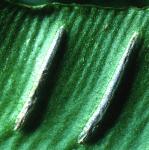
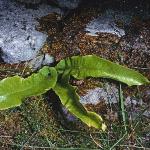
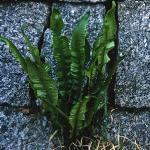
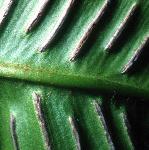
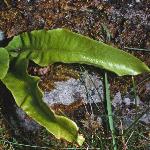
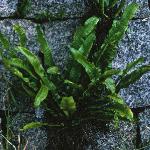


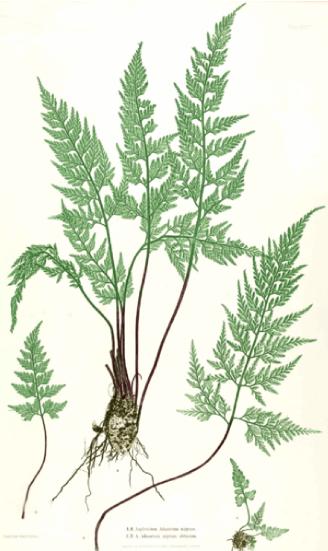
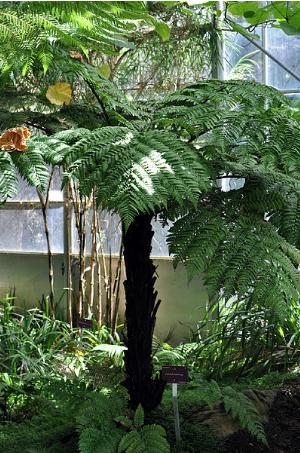 The foliage of the "Lady Fern" (Athyrium filix-femina) and the "Male Fern" springs from a central crown. This crown is the top of the caudex or stem, which slowly increases in thickness and length year by year. In these Ferns the stems are of upright growth, and occasionally rise above the ground a few inches.
The foliage of the "Lady Fern" (Athyrium filix-femina) and the "Male Fern" springs from a central crown. This crown is the top of the caudex or stem, which slowly increases in thickness and length year by year. In these Ferns the stems are of upright growth, and occasionally rise above the ground a few inches. 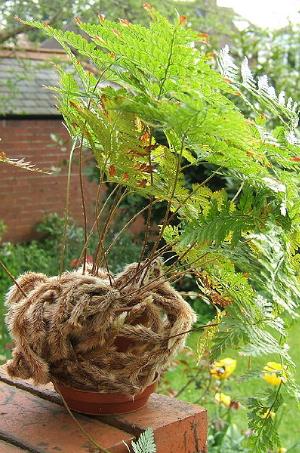
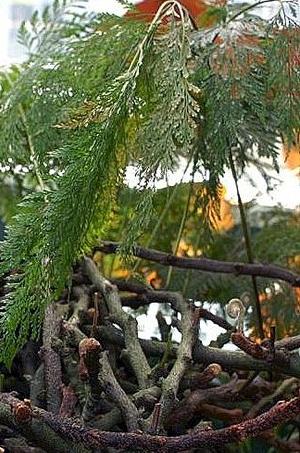 The rhizomes of this species are covered thickly by a light brown, woolly-looking substance. When they divide into 3 or 4 side growths, their appearance warrants the application of the common name.
The rhizomes of this species are covered thickly by a light brown, woolly-looking substance. When they divide into 3 or 4 side growths, their appearance warrants the application of the common name.